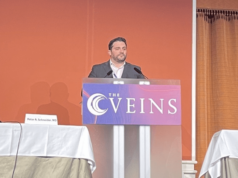 The common diagnosis of post-thrombotic syndrome (PTS) includes a history of deep venous thrombosis and a Villalta Scale score of four or above. However, a recent study conducted by JOBST Vascular Institute of ProMedica, examining whether misclassification bias might occur in using the Villalta scale for this diagnosis, has observed a positive misclassification rate of up to 42%. The abstract was presented by its primary author Felix Trinh at the 2018 American Venous Forum (AVF; 20–23 February, Tucson, USA).
The common diagnosis of post-thrombotic syndrome (PTS) includes a history of deep venous thrombosis and a Villalta Scale score of four or above. However, a recent study conducted by JOBST Vascular Institute of ProMedica, examining whether misclassification bias might occur in using the Villalta scale for this diagnosis, has observed a positive misclassification rate of up to 42%. The abstract was presented by its primary author Felix Trinh at the 2018 American Venous Forum (AVF; 20–23 February, Tucson, USA).Positive misclassification bias may occur in a percentage of patients who meet the criteria of high Villalta score and a history of deep vein thrombosis, while having no post-thrombotic changes in deep veins on venous duplex, Trinh argued. Similarly, negative misclassification bias occurs for patients who do not meet the standard criteria for diagnosis, despite having post-thrombotic changes in deep veins on venous duplex.
Along with co-investigators, Trinh conducted a study quantifying both positive and negative classification biases among patients referred to a vein clinic with chronic venous disease over a 12-month period.
The results saw a significant rate of positive misclassification at 42%, while negative misclassification rates at 3% were “very low”, the study authors write. All patients (n=288) completed Villalta scoring as well as a Venous Clinical Severity Score (VCSS) and a bilateral duplex ultrasound examination. While nine patients presented telangiectasies or reticular veins, the other 96% of patients (279/288) had varicose veins. In addition, healed and open ulcers could be seen in five patients, respectively, while 39 patients had skin changes and 62 patients experienced swelling.
The majority of the patient cohort did not have previous experiences of deep vein thrombosis, with an overall Villalta score of 8.12±4.91 (p=0.14). For the 30 patients with history of deep vein thrombosis, Villalta scores were higher, at 9.57±5.78 (p=0.14), with 26 of those patients recording Villalta scores ≥4. However, on ultrasound, 11 of those patients (42%, n=26) were revealed to have normal deep veins. Meanwhile, all four patients with a history of deep vein thrombosis and Villalta scores <4 showed post-thrombotic changes on ultrasound, with two femoropopliteal obstructions and two iliofermoral occlusions.
“The Villalta score is a series of symptoms and signals that are not specific to post-thrombotic syndrome”, Trinh said at AVF. “Use of the Villalta Score may be misleading”, he continued, as post-thrombotic syndrome diagnosed with the Villalta scale might partly reflect other conditions, including pre-existing symptomatichronic venous disease.
Co-author of the abstract and President of the AVF 2018 meeting, Fedor Lurie (University of Michigan, Ann Arbor, USA), spoke to Venous News about the findings. “Several publications and multiple presentations at scientific meetings addressed shortcomings of the Villalta scale”, Lurie said. “This is the first study that actually measured the miss-classification bias. The benefit of this is that we can now re-evaluate results of those studies that used Villalta scale, performing a real sensitivity analysis using the value of this bias. By doing so some of the results may be validated and some will be not.
Commenting on the findings of the study, Lurie said he was surprised that the negative miss-classification bias is not more extensive. “This means that the studies that used Villalta scale do not underestimate the incidence and prevalence of post-thrombotic syndrome. I was also surprised that the positive bias is so large. Up to half of all patients who develop deep venous thrombosis have pre-existing venous disease. Many of these patients were miss-classified as having post-thrombotic syndrome. We do not know how many of these patients were included in trials like ATTRACT and SOX, which makes me question their conclusions”, Lurie said.
The manuscript is not yet submitted for publication at the time of writing.












